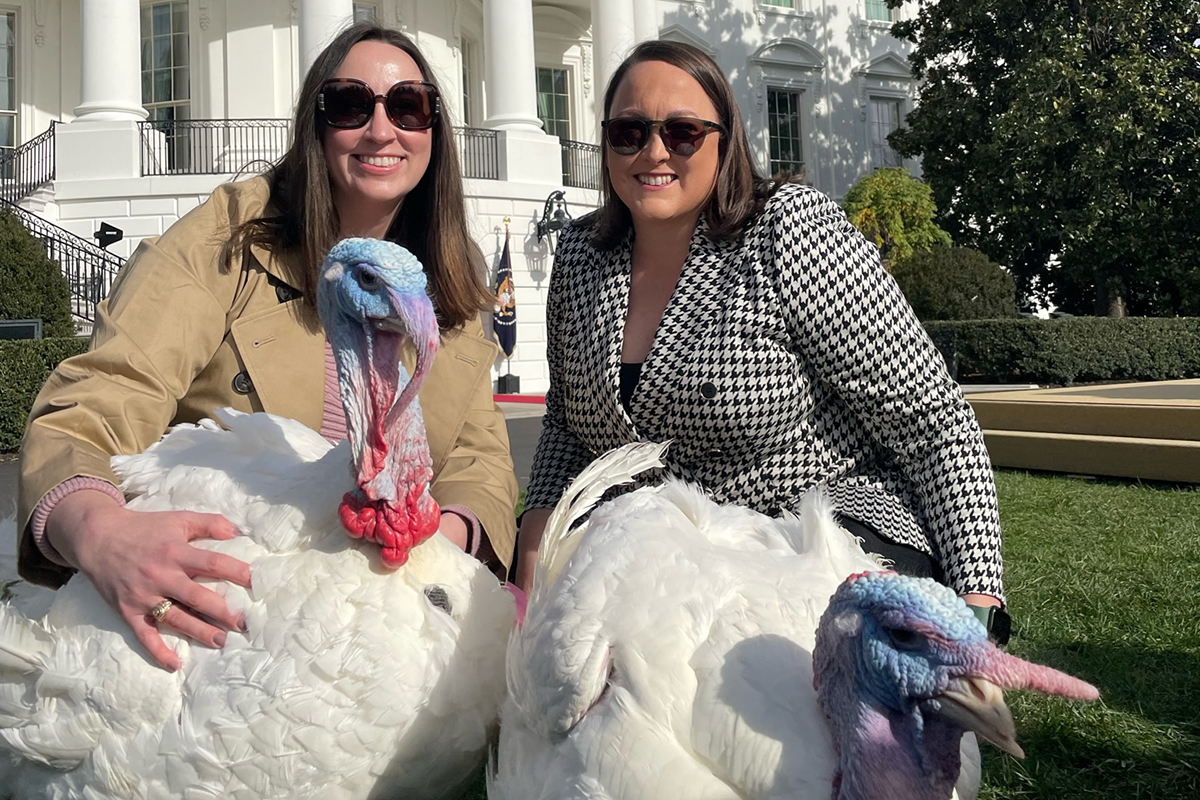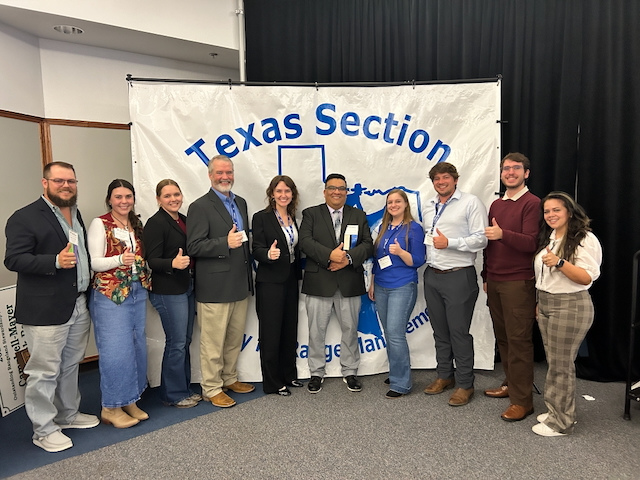Interstellar soil science: Aggie researcher explores farming on Mars
Coker’s reduced gravity plant growth research spends a week on International Space Station
In a fusion of soil science, space exploration and brewing beer, Texas A&M College of Agriculture and Life Sciences Department of Soil and Crop Sciences doctoral student Harrison Coker ’23 is leading research that could one day help humans thrive on another planet.
At Texas A&M, Coker found mentors in the Department of Soil and Crop Sciences, including Julie Howe, Ph.D., professor of soil chemistry and fertility and associate department head, and Peyton Smith, Ph.D., associate professor of ecology of soil carbon dynamics.
With their guidance, Coker secured a NASA fellowship and private industry support, transforming a childhood captivation with space into groundbreaking research on regolith-based agriculture, the science of growing plants in extraterrestrial soils.
Building on that momentum, Coker found a unique research opportunity when he partnered with Starbase Brewing in Austin on a project exploring how brewing byproducts could enhance soil health in lunar and Martian simulant soils.
Together, these collaborations are helping Coker turn imagination into innovation and lay the groundwork for sustainable food production beyond Earth.

Partnering with industry for out-of-this-world innovation
When Coker enrolled at Texas A&M University in 2018, he didn’t know space agriculture was a career option.
That changed when he started his doctoral work. After earning dual bachelor’s degrees in renewable natural resources and forestry, he joined Howe’s lab and began to learn more about the soil environment.
Coker was soon awarded a doctoral fellowship through NASA’s Space Technology Graduate Research Opportunity, and the team began researching soils on the Moon and Mars. Specifically, they wanted to learn how those soils could be used in future outposts to grow plants and cycle nutrients.
Mission Highlights
- Experiment: OASIS (Optimizing Agriculture in Simulated Interplanetary Soils)
- Location: International Space Station
- Launch: Space X 11, August 2025
- Goal: Study plant-microbe communication in microgravity
After receiving the NASA fellowship, Coker reached out to Starbase Brewing CEO Nate Argroves to talk about science collaboration. Starbase Brewing’s goal is to establish the first brewery on Mars, and Coker presented Argroves with ideas for agricultural research.
With Argroves’ support, the team decided to try adding brewer’s spent grain, BSG, to the lunar and Martian simulant soils to boost plant productivity. BSG is a byproduct of brewing beer and an organic matter source rich in nutrients. The trials with BSG performed well and led to significant improvements in crop growth in lunar and Martian simulants.
“The regolith is basically rocks and undeveloped parent material, and plants don’t really grow in rocks – it’s organic matter that gives soil its life and speeds the development of rocks into an arable soil,” Coker said.
Argroves contacted Coker in February to say he was going to send up the first experiment to brew a beer on the International Space Station and said, “We have extra payload space. Would y’all be interested?”
“This was the most fortunate experience I possibly could have had as a graduate student and as a scientist,” Coker said. “As a kid, I always dreamed of the space age. But I never knew how to pursue that.
Experiment launched into space
“The opportunity presented by Starbase Brewing and the support we received from the College of Agriculture and Life Sciences allowed the opportunity to unfold into the most exciting time of my life. It’s safe to say that I have caught the itch for spaceflight research.”
Starbase Brewing had already designed the first experiment to brew a beer in space, named MicroBrew-1. Leveraging the opportunity for additional payload space, Coker and the team designed a new research project, Optimizing Agriculture in Simulated Interplanetary Soils, OASIS, to test how barley grows in Martian regolith simulant with added organic material and microbes to mimic farming on Mars.
The team built on its months of previous experience utilizing BSG in Martian simulant soils.

OASIS and MicroBrew-1 launched to the International Space Station on Aug. 1 on NASA’s Crew-11 mission as part of the Jaguar Space One payload. The entire team visited Kennedy Space Center together to watch the launch, where Coker was spending the summer working as a NASA visiting technologist.
The experiment splashed back down on Earth on Aug. 9, and the samples were retrieved from NASA on Aug. 12 and brought back to Texas A&M.
In addition to Coker, Howe and Smith, the research team includes graduate student researchers Caleb Shackelford and Aenghus Denvir, undergraduates Emily de la Fuente and Suravi Dhar, and Luis Zea, Ph.D., CEO of Jaguar Space, who served as the launch provider.
“We got to send this experiment to space, and it’s back with us now to do more research,” Coker said. “This is a tremendously rewarding experience to get to lead this project, and I am incredibly thankful to Texas A&M for facilitating this and Starbase Brewing for providing this opportunity.”
Testing the limits of plant life in space
On top of the usual excitement before a mission, there was a lot of pressure for precision leading up to the launch, Coker said, “because unlike a normal experiment which you can repeat most of the time, this was a one-time chance – it has to work correctly on the first try.”
After learning of the opportunity to send their barley plants into space, Coker and his lab team spent all summer developing the experimental design needed to get the plants into space.
While at the Kennedy Space Center for his fellowship, Coker determined how much simulant, water, and organic matter to add, as well as how long plants can live in this environment. Shackelford, back on campus, headed up the microbial experiments and engineered a holder to keep the plants upright without gravity.



“There is a synergy with my lab group that pushed us forward, and the experiment wouldn’t have gone so well without Shackelford and the rest of the team,” Coker said. “It was a crunch to get it done, but we were successful in creating plant-microbe-soil systems to use.
“With those systems, we are now able to continue doing some really cool research. We’ll use a multi-omic approach that leverages metabolomics and metagenomics to see how the plant-microbe system was altered in the samples sent to space.”
The spaceflight experiment will be compared to a ground-based control, where identical temperature and lighting were provided based on sensor readings throughout the spaceflight.
Soil-based experiments for regolith-based agriculture have never been performed in microgravity. The team is excited to assess changes in greenhouse gases and other volatile emissions from plants and microbes, the nutritional status of plants, and plant-microbe interactions. The overarching goal is to determine how increased radiation and microgravity alter plant productivity in the closed-loop environments of space.
Why does it matter?
By studying this fundamental system, he said, they can look at sustainably growing plants in soil in a space colony. It’s imperative to understand how soil provides nutrients to plants in environments beyond Earth.
Current approaches to growing plants in space require nutrient streams and hydroponic solutions, which are unfortunately not sustainable for long-duration human missions.
“This is really important to know if there are to be space colonies one day with grasses and trees and bugs,” Coker said. “We want to know when you are growing those plants in a reduced gravity environment with low-quality soils and higher radiation — what is the effect?”





